- Home
- J. -H. Rosny aîné
The Givreuse Enigma
The Givreuse Enigma Read online
The Scientific Romances of
J.-H. Rosny Aîné
THE GIVREUSE ENIGMA
And Other Stories
translated, annotated and introduced by
Brian Stableford
A Black Coat Press Book
Introduction
This is the fifth volume of a six-volume collection of stories by J.-H. Rosny Aîné (“the Elder”), which includes all of his scientific romances, plus a number of other stories that have some relevance to his work in that genre.1
The contents of the six volumes are:
Volume 1. THE NAVIGATORS OF SPACE AND OTHER ALIEN ENCOUNTERS: The Xipehuz, The Skeptical Legend, Another World, The Death of the Earth, The Navigators of Space, The Astronauts.
Volume 2. THE WORLD OF THE VARIANTS AND OTHER STRANGE LANDS: Nymphaeum, The Depths of Kyamo, The Wonderful Cave Country, The Voyage, The Great Enigma, The Treasure in the Snow, The Boar Men, In the World of the Variants.
Volume 3. THE MYSTERIOUS FORCE AND OTHER ANOMALOUS PHENOMENA: The Cataclysm, The Mysterious Force, Hareton Ironcastle’s Amazing Adventure.
Volume 4. VAMIREH AND OTHER PREHISTORIC FANTASIES: Vamireh, Eyrimah, Nomaï.
Volume 5. THE GIVREUSE ENIGMA AND OTHER STORIES: Mary’s Garden, The Givreuse Enigma, Adventure in the Wild.
Volume 6. THE YOUNG VAMPIRE AND OTHER CAUTIONARY TALES: The Witch, The Young Vampire, The Supernatural Assassin, Companions of the Universe.
The first volume of the series includes a long general introduction to Rosny’s life and works, which there is no need to repeat here; the following introduction will therefore be limited to a brief account of the stories included in this volume, which will be supplemented by a more detailed commentary contained in an afterword.
The three stories collected in this volume are not thematically connected, as the stories in each of the first four volumes were, and there is a sense in which this volume merely picks up oddments that continue or digress from the themes established in the first three of those volumes. “Le Jardin de Mary” (here translated as “Mary’s Garden”) was presumably published in a periodical before being reprinted in the Plon collection Resurrection (1895), but I have been unable to trace or date its original publication. It is, however, undoubtedly an early work—a product of the same “passion for science” that produced “La Légende sceptique” (1889; tr. in vol. 1 as “The Skeptical Legend”).
One of the projects that Rosny recalled working on during his first year in Paris, 1885, was entitled Le Livre étoilé [The Starry Book], and that title was included in a list of books that Albert Savine apparently planned to publish, before changing his mind; one is tempted to wonder whether “Le Jardin de Mary” might not be a fragment escaped from that book, but there is no way to know. If it is, the novel in question might well have been akin to Camille Flammarion’s Stella (1877), which describes the education of a female visionary in the science of astronomy. The materialist Rosny would inevitably have avoided the naked mysticism of the latter novel’s ending in favor of the subtler quality of the terminus described here. Mary’s final assertion presumably refers to Rosny’s notion of “planetary physiology,” as expressed in “La Légende sceptique,” rather than to Flammarion’s notion of cosmic palingenesis, introduced in Lumen (1867-69 in periodicals; 1872 in Récits de l’infini; expanded for separate publication in 1887) and popularized in Rêves étoilé (1888) and Uranie (1889). Even if Rosny’s story is not directly derived from the ill-fated Livre étoilé, it presumably sprang from the same source of inspiration, and represents Rosny’s most straightforward literary extrapolation of his enduring fascination with the starry sky.
The publication of L’Enigme de Givreuse (here translated as “The Givreuse Enigma”) by Ernest Flammarion—Camille’s brother—in 1917 was probably also belated. After Plon’s publication of the book version of La Force mystérieuse (1914; tr. in vol. 3 as “The Mysterious Force”), which had appeared as a serial in 1913, Rosny had not succeeded in publishing any new books for an interval of three years, presumably because of the effects of the Great War. He began publishing again in 1917 when Flammarion issued a novel directly concerned with the war, which might be regarded as a propaganda piece, Perdus? [Doomed?], quickly following it up with L’Enigme de Givreuse, which also contains a morale-boosting episode in which a French inventor develops a new weapon and deploys it heroically in an attack on a German submarine. That episode is entirely gratuitous, however, and was probably inserted into a pre-existing manuscript in order to make the novel publishable in war-time.
If one ignores the gratuitous insertion, the content and form of L’Enigme de Givreuse strongly suggest that it must have been started as an exercise in the subgenre of “scientific marvel fiction” identified by Maurice Renard, who had tried hard in the years before the war to persuade Rosny that he was a significant pioneer of that kind of fiction, and to persuade Rosny to write more of it; L’Enigme de Givreuse was probably the third result of that persuasion, after “La Mort de la Terre” (1910; tr. in vol. 1 as “The Death of the Earth”) and La Force mystérieuse, and might have been started, if not actually completed, in the latter months of 1914, when the early events described in the story are set. It is the most theoretically-adventurous of Rosny’s scientific marvel stories, although the author evidently became more interested, while in the process of writing it, in the unusual existential predicament thrust upon its protagonist.
La Sauvage aventure, published by Albin Michel in 1935, was the final version of Rosny’s most oft-repeated plot formula—featuring the abduction of a woman by a human of a different race, occasioning a pursuit by her own people—which he had first employed in “Nymphée” (1893; tr. in vol. 2 as “Nymphaeum”) and repeated many times over in stories translated in the earlier volumes of this series. Here the story is presented as a straightforward exercise in pulp fiction, probably in response to the fact that Rosny’s final prehistoric romance Helgvor du fleuve bleu (1930; tr. as “Helgvor of the Blue River”) had been translated in the US pulp magazine Argosy. It may well have been written in a hurry, based for convenience on the near-identical plot of “Les Hommes-Sangliers” (1929; tr. in vol. 2 as “The Boar Men”), but substituting a different conclusion a little more suited to pulp romance.
If La Sauvage aventure was an attempt to get back into the US pulp market, however, it failed, and the novel remained untranslated until now. Some bibliographical lists give the date of its original publication as 1932, but I have been unable to trace any serial version issued in that year. It is perhaps the least satisfactory of all Rosny’s exotic adventure stories, if only because everything in it is second-hand, giving it the appearance of an exercise in self-plagiarism, but its inclusion here rounds out that aspect of his work and serves to re-emphasize the mysterious force that drew him back to the formula so insistently.
The version of “Le Jardin de Mary” that I used for translation is the one contained in the 1975 Marabout omnibus of Rosny’s speculative fiction, Récits de science-fiction. The versions of the other two texts that I used were the first editions in volume form.
Brian Stableford
MARY’S GARDEN
As Mary approached death she entered into a lucid delirium, in which she became a child again, with all sorts of old beliefs that had vanished over time. Then she said to the man who loved her: “Let’s go see the garden in which I shall dwell.”
The man who loved her knew perfectly well that she was talking about the firmament, and burst into tears. But Mary insisted so strongly that the doctor thought it best that she go to see the sky that was causing him such grief.
The little rooftop observatory where Mary had studied the stars was warmed up, and the dying woman was taken to it.
The glass walls were so transparent that one might think that one was in the open air, and Mary propped herself up on her elbow to study her garden.
The air was marvelous; the delightful infinity was full of little points of light. The Milky Way displayed its fine gauze, sown with constellations. The quaternaries of Sagitta were hanging low in the west, ready to set. Cygnus traced its cross against the milky background, and Cassiopeia its Y. Perseus gathered his stars, Auriga his pentagon, in which the superb diamond of Capricorn threw forth its fire. Very low, in the south-south-east Monoceros was extended, a white asterism between Procyon, the Gemini and the dazzling Orion.2
Nothing was moving. The Earth’s heat was radiating away, and an intense frost made the snow on the roof glitter. Mary’s eyes shone very brightly; a little blue scarf rendered her angelic face even whiter. She smiled at her beautiful garden and put her hands together, then continued her voyage.
She had moved out of the Milky Way; she wandered among the blue surfaces. She travelled through the stars of the hyperborean regions. Ursa Major and Ursa Minor dragged their tails there, Draco uncoiling between them and lifted its head toward Hercules; the ravishing Vega, the blue pupil of the north, palpitated over Lyra.
“Dear, dear Vega!” sighed Mary.
She remained magnetized for a few moments by the star, as it sent the long threads of its radiance into redoubtable spaces—and, in the night full of peace, her sweet reverie and her dying enthusiasm seemed to loom over the white roofs, the square and the trees like a blessing.
She idled slowly as she descended westwards. From the scattered stars of Delphinus she passed the pale constellation of Equuleus, and from Aquarius she climbed back toward the zenith via the superb Pegasus, whose immense square dominated the corner of Pisces.
Then she paused briefly. In the pure blue, the marvelous Mira Ceti shone, at the apogee of its magnificence. Mary sang “Twinkle, twinkle, little star” in a voice so weak that the man who loved her had to hide his face; then she went up to the zenith again, via Aries and Triangulum, and reached Andromeda and Perseus, in a swarm of stars, and finally the great region of fire. The primaries accumulated, their red and white light overlapping. The red eye of Taurus, Aldebaran, trembled gently against the golden background of five tertiaries. The splendid belt stars3 stood out in the center of Orion, whose giant rectangle extended, brightened by Betelgeuse and the double star Rigel. Then, in profusion, Procyon, Pollux, Castor and Capella opened their radiant corollas on the dark beach, amid the bright stream of their constellations.
Then, paler still, Mary felt her enthusiasm mount, an enthusiasm of light, of the divine palpitation of infinity. It was as if she were giving way beneath the immeasurable weight of the stars, while her bosom caused the blonde lace of her corsage to tremble gently.
“Look,” she murmured. “My brightest flower is about to rise!”
She pointed to the south-east. Lepus had leapt. A gleam fringed the line of the horizon. Two quaternaries were positioned on the edge of the Milky Way, and Sirius emerged. Shivering, Mary watched it climbing the blue slope for some time. Sirius! The finest of the gems of space, white with a bluish tint, which takes 14 years to send us a little sapphire quiver!
“How beautiful it is!” said Mary, taking my hand. “I’d like to go while gazing at it, with your head against mine.”
I put my head next to hers, and I heard something terrible coming, which comes to the Earth incessantly. But she murmured: “All that is so far away, you see, and yet so close that we can see it with our feeble eyes. That’s why, my dear friend, my dear lover, it’s necessary to believe that nothing is foreign to us. There are no other worlds; all of this is in contact. If one is so afraid to leave, it’s because any parting is sad, and this is the greatest of all departures. But you will come; nothing is more certain.”
She continued wandering, with a profound gentleness, and I felt that I was becoming a child again, in spite of the something that was still drawing nearer.
“Give me a kiss,” she said.
I gave her a kiss, with all my heart, and then she murmured, in a breath: “Au revoir!”
She had gone, and I was dreaming through my sobbing, that all of this was indeed in contact, and that I really was much closer to Sirius, much closer to the most distant nebula, than to the child that I loved.
THE GIVREUSE ENIGMA
Part One
I.
One evening in the first half of September 1914, four stretcher-bearers were crossing the heath of the Loup Rouge. Darkness was falling, formidable and terrific. Between the sky and the ground it was Hell; a furnace of sulfur and blood was disclosed in the clouds. Man-made thunder growled beyond the hills, shaking the trees to their roots and the rocks to their depths. The stretcher-bearers were coming back from the field-hospital and returning to the killing-ground. One of them mopped his brow and murmured: “They’ve all been picked up.”
“We’ve advanced again,” replied his companion.
There was horror on the heath. The blood formed pools, coagulating amid the grass. Cadavers were extended, peaceful and sinister. Suddenly, a hand was raised beneath a tree-stump and a feeble plaint was heard.
“One that wasn’t noticed!” said the one who had spoken last. He went to the stump.
A soldier was looking round, dazedly. He was a tall man, whose face was scarcely muddied by the shell-fire. His hair was reminiscent of the color of ripe oats and his moustache that of spelt straw; he had large jade-colored eyes, feminine cheeks and a high forehead sharply angled at the temples. Black blood was drying on his skull.
“It’s all right,” said the stretcher-bearer, “someone’s here.”
The man did not reply. His eyes were misted; he seemed to be about to fall asleep.
“Not a good sign,” the stretcher-bearer went on. “Hey, Charlet, are we taking him?”
Charlet, however, was going toward a tall clump of bracken, attracted by some clue. “Another!” he muttered. He had perceived the other one at the same time as the man discovered by his comrade, through a gap in the bracken. The dusk had scarcely begun to gather; the air was diaphanous.
Charlet looked at the two wounded men and remarked: “One might think that they were related.” Then, with increasing astonishment, he added: “It’s quite extraordinary. They must be twins! Come on then, Henriquet!”
A red-haired stretcher-bearer came over to the two wounded men in his turn and declared, with conviction: “They’re twins, and no mistake!”
The second wounded man reproduced the features of the first identically; he too had clotted blood in his hair. His jade-colored eyes were misted by a dream, and one might have thought that he was about to fall asleep.
“That’s rare!” Charlet observed.
“Right! What about their identity tags? Let’s see: Givreuse, Edouard-Henri-Pierre. And the other?”
“I can’t find anything—his tag’s been removed.”
“That’s okay,” said Henriquet. “We’ll find out later. Time’s pressing—let’s not dawdle. It seems to me that they ought to be kept together.”
Henriquet and Charlet loaded the man from the tree-stump on to their stretcher, while the other two loaded up the man from the bracken. There was no indication that the wounded men were conscious of what was happening.
The little company left the heath and went through the grounds of Grantaigle. The château’s two towers were visible, one of them collapsed. A chapel raised its thin steeple in front of a copper and aquamarine cloud. A look-out post was dangling from the crumbling, smoking walls. A flock of crows fled over blue beeches while flames scaled the debris. One of the stretcher-bearers, who was an educated man, murmured: “One would think we were in the times of Philippe-Auguste.”
They went past the château; the field-hospital—a large shed and some huts—appeared at the far end of a field, on the edge of a small village. Plaints rose up, punctuated with a wild clamor, and the scent of rotting flesh spread around, min
gled with less precise odors.
On the threshold of the first hut, a medical orderly barred the way. “Full up! The hut’s bursting. Over there, look—the sixth should still have space…”
At the “sixth” a corpulent doctor was washing his hands in a bowl. Large folds of flesh hung down from his slack jaws. “It’ll be the death of us!” he cried, on seeing the new arrivals.
“It’s one case,” Alexandre observed, softly. “Twins, Major.”
“What do you want me to…?”
“All the same, it’s rare that one sees the like on a battlefield.”
The major turned his surly gaze to the two soldiers, distractedly at first, and then more attentively. “They’re as similar as two of the 69th’s shells!” he muttered. “Where did you pick them up?”
“On the heath, near the Château de Grantaigle.”
“I didn’t know…”
“Thirty paces apart…”
The major leaned over each of the men in turn. “There’s a difference, though. One’s face seems slightly...very slightly…longer than the other’s.”
“Do you think so?” said Charlet.
A tall, slender woman approached, like an oread in her white uniform. She studied the two wounded men with an alarm that gradually became intense. “One would think that they had the same wound on their heads,” she said, uncertainly.
The doctor parted the blood-matted hair as best he could, and became pensive. “It’s fantastic! One would think that two identical pieces of shrapnel had struck in the same place.”
There was a pause. The major seemed ill-at-ease. The stretcher-bearers looked at one another vaguely and the woman put her hands together in a mechanical gesture.
“No, it’s not natural!” sighed the stretcher-bearer named Alexandre, finally.

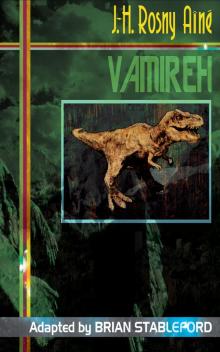 Vamireh
Vamireh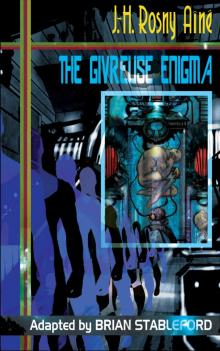 The Givreuse Enigma
The Givreuse Enigma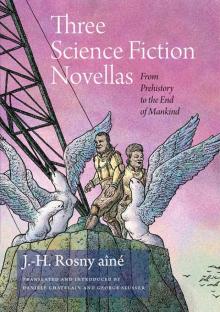 Three Science Fiction Novellas: From Prehistory to the End of Mankind
Three Science Fiction Novellas: From Prehistory to the End of Mankind Helgvor of the Blue River
Helgvor of the Blue River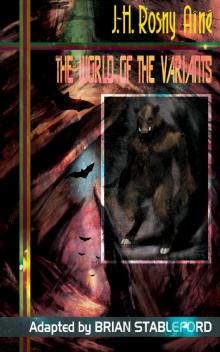 The World of the Variants
The World of the Variants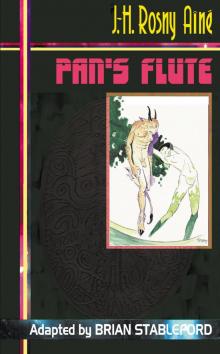 Pan's Flute
Pan's Flute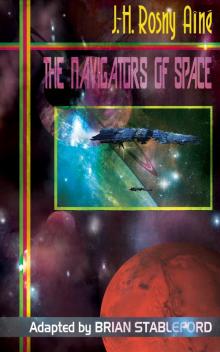 The Navigators of Space
The Navigators of Space The Mysterious Force
The Mysterious Force